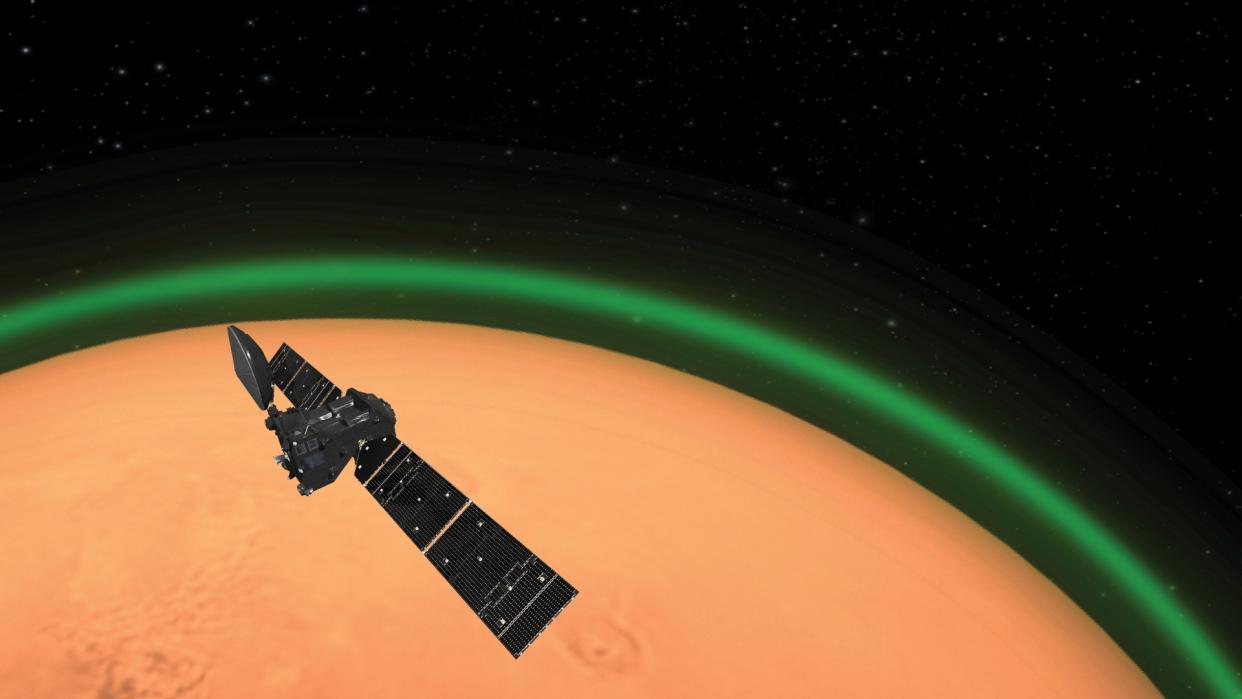Mars probe sees Red Planet atmosphere glowing green at night

Mars might be the Red Planet, but its atmosphere glows green.
Using the European Space Agency's (ESA) ExoMars Trace Gas Orbiter (TGO), scientists have observed Mars' atmosphere glowing green for the first time ever — in the visible light spectrum, that is.
The effect is called airglow (or dayglow or nightglow, depending on the hour), and it occurs on Earth, too. While it shares some similarities with the northern lights (or aurora) here on our planet, it's a different phenomenon with different causes. Nightglow, in particular, "occurs when two oxygen atoms combine to form an oxygen molecule," according to ESA. On Mars, this happens at an altitude of approximately 31 miles (50 km). By comparison, auroras occur when charged particles from the sun collide with Earth's magnetic field.
Scientists have suspected Mars to have airglow for some 40 years, but the first observation only occurred a decade ago by ESA's Mars Express orbiter, which detected the phenomenon in the infrared spectrum. Then, in 2020, scientists observed the phenomenon in visible light using TGO, but in Martian daylight rather than at night. Now, we've seen the phenomenon at night via TGO.
Related: Citizen scientists detect patterns in clouds over Mars
"These new observations are unexpected and interesting for future journeys to the Red Planet," ULiège planetologist Jean-Claude Gérard," said in an ESA statement. "The intensity of the night glow in the polar regions is such that simple and relatively inexpensive instruments in Martian orbit could map and monitor atmospheric flows. A future ESA mission could carry a camera for global imaging. In addition, the emission is sufficiently intense to be observable during the polar night by future astronauts in orbit or from the Martian ground'.
RELATED STORIES:
— Rare streaks of light above US are a sign that solar maximum is fast approaching
— Eerie ring of red light flashes like a massive UFO above Italy. What was it?
Studying Mars' nightglow, which will continue as part of the TGO mission, will also give scientists insight into processes that occur in the Martian atmosphere. "Remote sensing of these emissions is an excellent tool for probing the composition and dynamics of Mars' upper atmosphere between 40 and 80 km [25 to 50 miles]," said Benoit Hubert, a researcher at the Laboratory for Planetary and Atmospheric Physics (LPAP) at the University of Liège. "This region is inaccessible to direct methods of measuring composition using satellites."
Studying Mars' atmosphere can also help with the design of future spacecraft destined for the Red Planet. A better understanding of its density can help mission planners build satellites that can withstand the drag the Martian atmosphere creates, for example, or design parachutes that can lower payloads down to the Red Planet surface.
The team's research was published in the journal Nature Astronomy on November 9.

